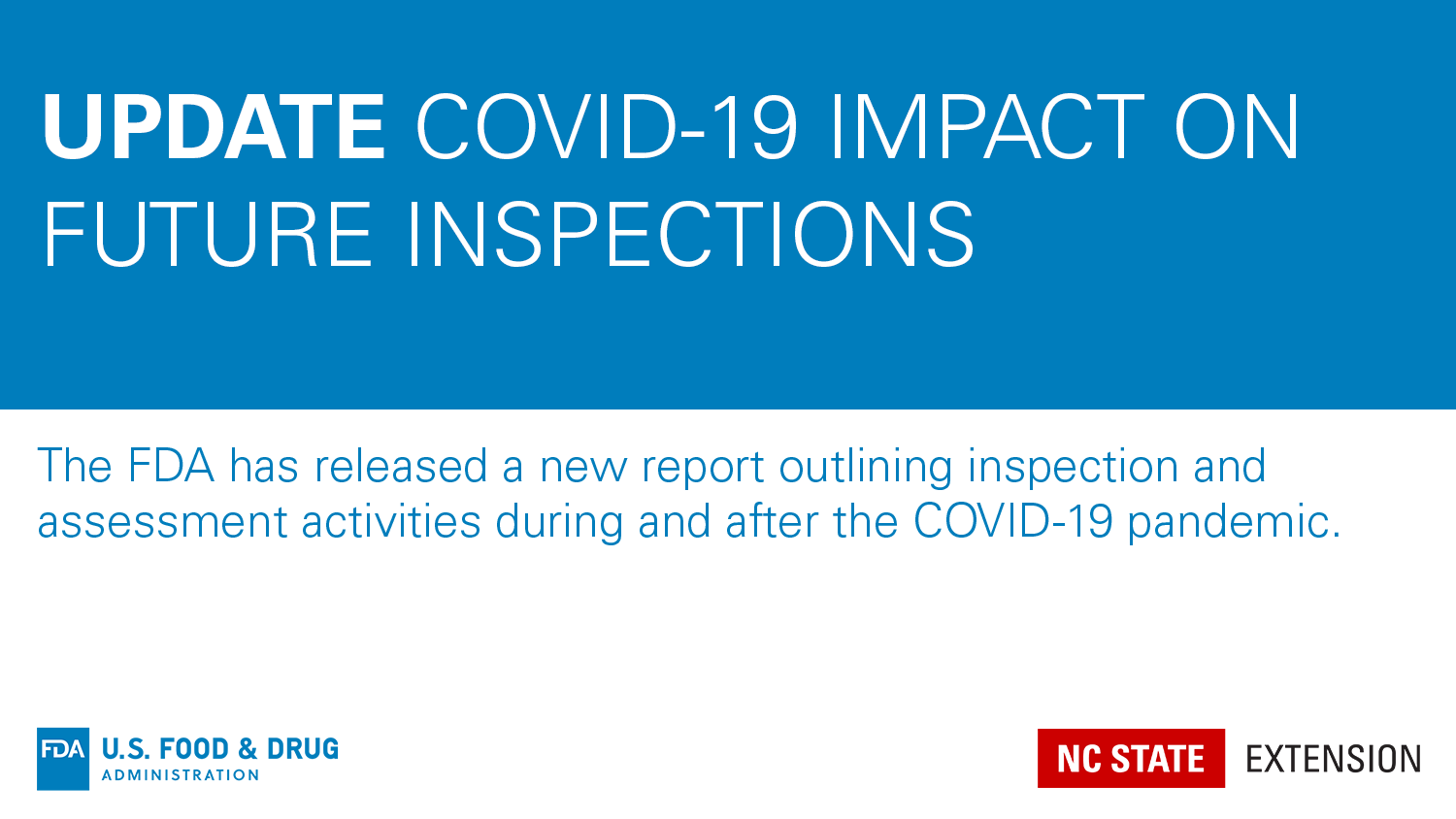PCAF Inspection Update: Resiliency Roadmap for FDA Inspectional Oversight
go.ncsu.edu/readext?795456
en Español / em Português
El inglés es el idioma de control de esta página. En la medida en que haya algún conflicto entre la traducción al inglés y la traducción, el inglés prevalece.
Al hacer clic en el enlace de traducción se activa un servicio de traducción gratuito para convertir la página al español. Al igual que con cualquier traducción por Internet, la conversión no es sensible al contexto y puede que no traduzca el texto en su significado original. NC State Extension no garantiza la exactitud del texto traducido. Por favor, tenga en cuenta que algunas aplicaciones y/o servicios pueden no funcionar como se espera cuando se traducen.
Português
Inglês é o idioma de controle desta página. Na medida que haja algum conflito entre o texto original em Inglês e a tradução, o Inglês prevalece.
Ao clicar no link de tradução, um serviço gratuito de tradução será ativado para converter a página para o Português. Como em qualquer tradução pela internet, a conversão não é sensivel ao contexto e pode não ocorrer a tradução para o significado orginal. O serviço de Extensão da Carolina do Norte (NC State Extension) não garante a exatidão do texto traduzido. Por favor, observe que algumas funções ou serviços podem não funcionar como esperado após a tradução.
English
English is the controlling language of this page. To the extent there is any conflict between the English text and the translation, English controls.
Clicking on the translation link activates a free translation service to convert the page to Spanish. As with any Internet translation, the conversion is not context-sensitive and may not translate the text to its original meaning. NC State Extension does not guarantee the accuracy of the translated text. Please note that some applications and/or services may not function as expected when translated.
Collapse ▲On May 5, 2021, the U.S. Food and Drug Administration (FDA) released a new report: Resiliency Roadmap for FDA Inspectional Oversight detailing inspectional activities during the COVID-19 pandemic and their plans moving forward. The report details three possible scenarios for more consistent inspections moving forward as well as the number of human and animal food investigations conducted since October 2019.
The FDA paused routine on-site inspections in the U.S. in March 2020 in response to the COVID-19 pandemic. Investigators continued for-cause inspections deemed mission critical by using tools such as remote assessments and import alerts.
In July 2020, the FDA announced their plans to resume domestic inspections with a new risk assessment system. With this system, the FDA used a COVID-19 Advisory Rating System to assess the number of COVID-19 cases in an area based on state and national data.
FDA will continue conducting mission-critical inspections and prioritized surveillance inspections at this time and will postpone other inspections due to the pandemic.
Moving Forward
Moving forward, the FDA plans to prioritize inspections based on the current and future state of the COVID-19 pandemic. The roadmap outlines three potential scenarios for future inspections during the pandemic:
- A gradual transition to standard operations (Base-Case);
- An immediate transition to standard operations (Best-Case); or
- Maintenance of an emergency-operations status (Worst-Case).
A number of variables will impact how the agency intends to move forward, including:
- the number of investigators available to conduct inspections,
- COVID-19 administrative leave’s impact on the number of available hours to conduct inspections,
- natural disasters, environmental factors, and other constraints that may affect staffing,
- challenges related to planning foreign inspections, and
- the ability of state agencies to conduct surveillance inspections.
According to the report, there are 12,285 human and animal food inspections remaining for fiscal year 2021, with 1,272 (10%) of these inspections achievable under the base-case scenario and 2,579 (21%) achievable under the best-case scenario. The agency will focus on mission-critical inspections under the worst-case scenario.
What Do We Know About Inspections?
Inspections are currently taking place and we want you to be as prepared as possible for your next inspection. Be prepared to be inspected under a number of different regulations during a single visit, including, but not limited to
- Food Safety Modernization Act
- Bovine Spongiform Encephalopathy (BSE)/Ruminant Feed
- Veterinary Feed Directive (VFD)
- Medicated Feed Current Good Manufacturing Practice
- Bioterrorism Preparedness and Response Act
We have a number of resources available to help facilities comply with the Food Safety Modernization Act (FSMA) Preventive Controls for Animal Food (PCAF) rule and for inspection preparedness.
How Animal Food Facilities Can Prepare for Regulatory Inspections
Though they can be a source of worry, the fact of the matter is that many animal food facilities often think about preparing for inspections as the inspectors walk through their doors. One of the reasons for this is because the “what if” questions can be large in number, and so facilities get frustrated with trying to come up with a plan. With this in mind, we asked some regulators what advice they have for facilities in order to be proactive and help make the process go more smoothly. This document presents a number of practices that are not required, but might be useful as facilities prepare for, are subjected to, and evaluate the results of inspections.
Food Safety Modernization Act Current Good Manufacturing Practices for Food for Animals and COVID-19
How existing facility Standard Operating Procedures (SOPs) on personal hygiene and sanitation can be adapted to mitigate the spread of COVID-19
If you have questions about inspections or animal food safety, contact Marissa Cohen.



